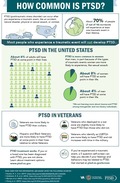|
Providing PTSD Care at End of Life
Sadie Larsen, PhD and Douglas Lane, PhD, ABPP
Wednesday, December 20 at 2:00pm ET
|
|
About the Topic
Patients receiving health care at end of life (EOL) may receive palliative and/or hospice care for their medical conditions. One task of end-of-life care is to help patients have a death that involves minimal pain and suffering as well as optimal emotional well-being and quality of life as defined by the patient. For patients with pre-existing PTSD, some may have had chronic symptoms, and others may experience a flare of symptoms during EOL, either of which can complicate the dying process for patients and their loved ones. Although there has been very little research on PTSD specifically at EOL, clinically-based suggestions can be combined with such research to identify emerging best practices. This presentation will help clinicians working with patients at EOL to think through how PTSD may present at end of life, and how they may assess for and help patients address PTSD in this unique context.
|
|
About the Presenters

SADIE LARSEN, PhD is a clinical psychologist on the Education Team at the National Center for PTSD and an Associate Professor at the Medical College of Wisconsin. Dr. Larsen specializes in Prolonged Exposure (PE) and Cognitive Processing Therapy (CPT) and is interested in helping clinicians provide evidence-based treatment while navigating the nuances of particular cases and the administrative and other challenges that come with systems change. Dr. Larsen has served as the Local Evidence Based Psychotherapy Coordinator and founder/lead of the Evidence Based Psychotherapy clinic at the Milwaukee VA. She supervised practicum students, interns and postdoctoral fellows in PTSD, general outpatient therapy, and addressing military sexual trauma. Her primary research interests involve better understanding variation in response to evidence-based treatments for PTSD, cognitive and emotional processes that maintain or alleviate PTSD symptoms, and the unique experiences of Veterans and of men and women who experience interpersonal and sexual trauma. Dr. Larsen received her PhD from the University of Illinois at Urbana-Champaign. She completed her predoctoral internship at University of Wisconsin and her postdoctoral fellowship in PTSD treatment at VA Boston.
|
|

DOUGLAS LANE, PhD, ABPP is a geropsychologist in the Geriatrics and Extended Care Service of the VA Puget Sound Healthcare System. He is also a Clinical Professor in the Department of Psychiatry and Behavioral Sciences of the University of Washington School of Medicine. He is board-certified in Geropsychology and Clinical Psychology by the American Board of Professional Psychology (ABPP). His clinical areas of interest are psychotherapy with older adults, psychotherapy integration, dementia care, resiliency factors and aging including spirituality, and coping with neurological disorders. In his free time, Dr. Lane is also a member of the medical staff for the Seattle Seawolves, the professional Major League Rugby franchise in Seattle.
|
|
|
PTSD and End of Life: Clinical Considerations for PTSD in Palliative or Hospice Care
At end of life (EOL), PTSD can make some of the tasks of health care—and of facing mortality—especially challenging. Providers can consider screening for trauma or PTSD and when that is not feasible, utilizing the principles of trauma-informed care to ease any suffering or distress that may be related to past trauma. This article is designed for an audience of clinicians who primarily work with patients at EOL (considered roughly a life expectancy of one year or less, though definitions vary) and may also be helpful for PTSD specialists whose patients become seriously ill or injured. Most writing and research on this topic involved Veterans—largely older male ones—and discussed combat-related trauma; it will be important for future work to consider the experiences of women and civilians, and other trauma types (e.g., sexual assault, racial trauma).
Read the full version of this article
|
|
Order New Posters

Our team recently created two new posters.
How Common is PTSD? (pictured here) describes the prevalence of PTSD in the US, worldwide, and in both Veteran and non-military populations.
Women and PTSD describes PTSD in women Veterans, including risk factors, common problems, and resources to learn about and access treatment.
You can order them and other posters for free from our Government Publishing Office catalog.
|
|
New Moral Injury Scale
The Moral Injury and Distress Scale (MIDS) is a self-report measure that assesses exposure to potentially morally injurious events (PMIEs) and the possible impacts of moral injury. It is designed to apply to a broad range of populations and types of PMIEs. The scale comprehensively assesses morally injurious emotional, cognitive, religious/spiritual, social, and behavioral sequelae, ranging from milder moral distress to more severe moral injury.
Read more and download the free scale
Holiday Blues
For Veterans with PTSD, the holiday season can be difficult to manage. You can share this blog post with Veterans who are struggling. It includes links to free coping tools and educational materials.
VA Can Help With Those Holiday Blues
|
|
 |
|
Our team of expert clinicians is available to consult with any healthcare provider treating U.S. veterans in any setting.
We can discuss assessment, diagnosis, psychotherapy, medications, collaborating with VA care, patient and family education, continuing education, and just about anything else related to veterans and PTSD.
No question is too big or too small.
Contact us at PTSDconsult@va.gov or 866-948-7880.
|
|
|
 |
|
www.ptsd.va.gov/consult |
|
|
|
|
|